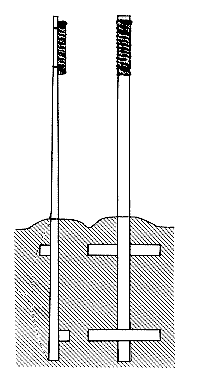Makiwara
The makiwara (巻藁) is a padded striking post used as a training tool in various styles of traditional karate. It is thought to be uniquely Okinawan in origin. The makiwara is one form of hojo undō, a method of supplementary conditioning used by Okinawan martial artists.

Use
The makiwara is used by karate practitioners to practice strikes in much the same way as a boxer uses a heavy bag. The makiwara develops one's striking ability by letting them experience resistance to punches, kicks and other strikes. A poor punch will bounce off the makiwara if the body is not in a position to support the energy generated by the strike. It also develops targeting, and focus, which is the ability to penetrate the target (i.e., opponent) to varying degrees of force.
The makiwara is very versatile, and can accommodate practice of open/closed hand strikes, kicks, knee strikes and elbow strikes. Okinawan methods emphasize striking from different angles. Most sources recommend a regimen of hitting the makiwara 50–100 times per day, with each hand. It is especially important to train the weaker side of the body as hard as, or harder than the dominant side. It is important to note that one should not use the makiwara so much that it causes them harm. Like all good training, there should be no lasting damage.
A round elongated makiwara, traditionally made from rice straw bound with rope, is used by practitioners of kyūdō, Japanese archery. This makiwara is placed on a stand so that it is near shoulder height, and is used for close range practice from about 5–8 feet away. The archer is practically unable to miss the target from that range, affording the kyūdō practitioner the opportunity to practice his form, without thought for the target.
Construction
The most common type consists of a single 7-to-8-foot-long (2.1 to 2.4 m) post driven into the ground, so that it is approximately shoulder height. The post is tapered from the bottom to a thickness of 1 cm at the top. Traditionally, a pad of rice straw (巻 maki "roll" + 藁 wara "straw") was bound to the top with rope to form a striking surface. However, duct tape and foam rubber padding will work just fine, and last longer outdoors.
Soft makiwara construction and use
Soft makiwaras are the type of makiwara that beginners use, but they are still essential for daily speed training for both beginners and experts alike. Soft makiwaras are often positioned at a greater angle from vertical and an average punch will straighten the makiwara to a vertical position.
Stiff makiwara construction and use
After the user is well conditioned from using the soft makiwaras, they often add additional training on the stiff makiwara to work on power training. The stiff makiwara is constructed by positioning the wood at a small angle from vertical. The average training punch to push the makiwara to a vertical position, or 90 degrees from the ground.
Types of makiwara
Shuri makiwara
The shuri makiwara is a flat board, measured to be as high as the instructor's breast bone. This makiwara is used when punching from a short stance.[1]
Naha makiwara
The naha makiwara is also a flat board, but measured to be as high as the instructor's solar plexus. This makiwara is used traditionally by goju-ryu practitioners, who train in a deep stance(Shiko dachi).[1]
Ude makiwara
The ude makiwara differs in that it is round on all sides. This allows for the practitioner to use a variety of strikes and kicks on the makiwara, that could not be used on flat boards.
See also
| Wikimedia Commons has media related to Makiwara. |
- Wolff's law (a possible explanation why bones strengthen with daily makiwara use)
- Stress fracture
- Boxer's fracture
- Mu ren zhuang
References
External links
- Detailed instructions on how to build a makiwara and makiwara pad
- More detailed instructions on how to make one
- Makiwara construction & Technique
(Wayback Machine copy)